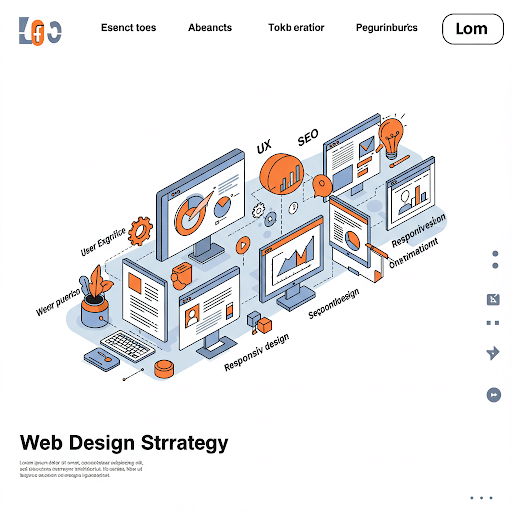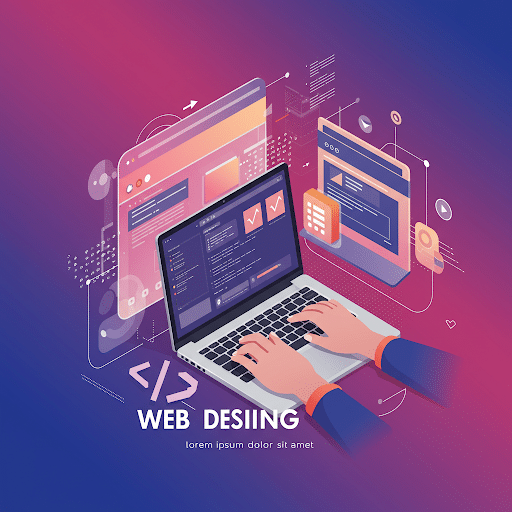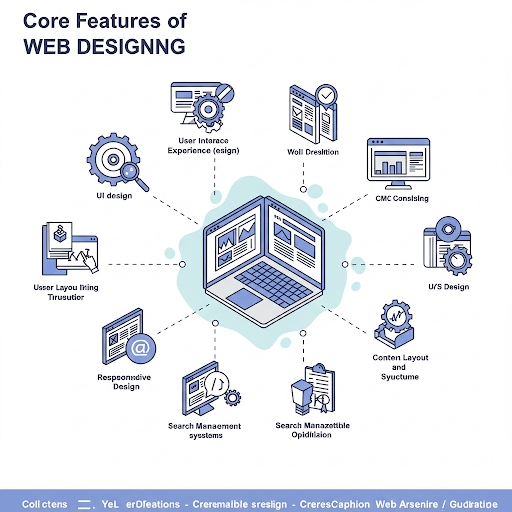Table of Contents
Toggle
Essential Elements of a Successful Web designing Strategy
A successful web design strategy is essential for creating a website that not only looks good but also serves the needs of its users and achieves business goals. The key to an effective strategy lies in understanding both design principles and user behavior. User experience (UX) should be at the heart of your strategy, ensuring that the website is easy to navigate, intuitive, and engaging. This begins with responsive design, which ensures that the site works seamlessly across different devices, from desktops to mobile phones. The visual design should reflect your brand identity, using consistent color schemes, typography, and imagery that align with your company’s values and resonate with your target audience.
Another essential element is content organization. A clear and logical structure, with well-defined categories and easy-to-understand navigation, helps visitors find what they are looking for without confusion. Your website must load quickly, so optimizing images and simplifying the backend code to minimize load times is crucial. Search engine optimization (SEO) should also be integrated into your strategy from the start, ensuring that the website’s content is discoverable by search engines and ranks well in search results.
Calls to action (CTAs) should be strategically placed throughout the website, guiding visitors toward the desired actions, whether that’s signing up for a newsletter, making a purchase, or contacting your team. Finally, accessibility plays a vital role in reaching a wider audience, including people with disabilities. This means ensuring that your website follows best practices for accessibility, such as using appropriate color contrasts, providing text descriptions for images, and making the site navigable by keyboard.
Incorporating these essential elements into your web design strategy creates a user-friendly, functional, and effective website that not only attracts visitors but also keeps them engaged and converts them into loyal customers. A well-planned strategy aligns design with business objectives, resulting in a website that drives long-term success.

What is Web Designing?
Web designing is the process of creating and planning the layout, structure, visual appearance, and user experience of websites. It involves combining elements like graphics, typography, colors, images, content, and interactive features to build websites that are not only visually appealing but also functional and user-friendly. A well-designed website helps businesses build their online presence, communicate with customers, and achieve their goals effectively.
For businesses looking to create a strong digital identity, partnering with the best web design company in Salem can make a significant difference. These companies specialize in crafting websites that are responsive, SEO-friendly, and tailored to meet the unique needs of different industries. A professional web development company in Salem not only designs visually engaging websites but also ensures smooth backend functionality and performance.
Whether you’re a startup or an established business, choosing the right website design company in Salem helps you create a website that stands out and delivers results. From modern UI/UX designs to mobile compatibility and fast load speeds, a reliable website development company in Salem ensures your site performs optimally on all devices. These services are crucial in today’s digital age where first impressions are often made online.
If you’re seeking innovation and technical excellence, a trusted web design company in Salem can deliver customized solutions that reflect your brand and engage your audience. With the growing importance of web designing in business strategy, investing in professional web design and development is more than just a digital upgrade—it’s a pathway to business growth and customer satisfaction
Functions of Web Designing
The primary function of web designing is to create websites that are visually appealing, user-friendly, and effective in delivering information or facilitating interaction between businesses and their audience. Web design serves as the digital face of a brand, and its core functions include:
Visual Communication
Web design helps convey a brand’s identity, message, and values through visuals—colors, fonts, images, and layout. A professional design builds trust and sets the tone for the user experience.User Experience (UX)
One of the key functions is to ensure smooth and intuitive navigation. Good web design helps users find information quickly and easily, improving engagement and reducing bounce rates.Content Presentation
It organizes and displays content in a way that is visually appealing and easy to read, using design elements such as headings, spacing, and graphics to enhance readability.Responsiveness and Accessibility
Web design ensures that websites are accessible on all devices (desktops, tablets, and smartphones) and usable by people with disabilities, expanding the site’s reach and usability.Conversion Optimization
By strategically placing calls to action (CTAs) and creating a logical flow, web design guides visitors toward desired actions, like making a purchase or contacting a business.Search Engine Optimization (SEO)
Design elements such as fast loading times, mobile responsiveness, clean coding, and structured layout contribute to better search engine rankings.Brand Consistency
Consistent use of design elements across all web pages ensures that the brand message is clear and cohesive, strengthening recognition and trust.Performance and Functionality
Web design works closely with development to ensure that interactive features like forms, menus, and multimedia function correctly, enhancing the overall experience.
Importance of Web Designing
Web designing plays a critical role in establishing a brand’s digital presence and directly impacts how visitors perceive your business online. In today’s competitive digital landscape, having a professionally designed website is no longer optional—it’s essential. Here are key reasons why web designing is important:
First Impressions Matter
Your website is often the first interaction potential customers have with your business. A modern, well-designed website builds trust instantly, while a poorly designed one can turn users away within seconds.Builds Brand Identity and Credibility
Consistent colors, fonts, logos, and layout help reinforce your brand image and create a memorable identity. A professional design shows that your business is credible and trustworthy.Improves User Experience (UX)
A thoughtful web design ensures users can navigate your site easily, find information quickly, and interact without frustration. This enhances engagement and encourages visitors to stay longer.Boosts SEO Performance
Search engines favor websites that are mobile-friendly, fast-loading, and well-structured—all of which are results of good web design. Better SEO means higher visibility in search results.Increases Conversions
Strategic placement of calls to action (CTAs), easy navigation, and clean design elements can guide users toward making a purchase, signing up, or contacting you—turning visitors into customers.Supports Mobile Users
With a growing number of users accessing websites via smartphones and tablets, responsive web design ensures your site looks and works great on all devices.Sets You Apart from Competitors
A unique and appealing design gives your business an edge over competitors. It shows professionalism and innovation, which can influence customer choice.Enhances Website Performance
Good web design is not just visual—it improves performance by optimizing loading speed, reducing bounce rates, and ensuring seamless interactions.Facilitates Marketing and Branding Goals
Your website is a key tool in digital marketing. It supports content marketing, social media campaigns, and email marketing efforts, all anchored by a solid, user-friendly design.Long-Term Business Growth
A well-designed website adapts with your business as it grows. It can scale, evolve, and continue to meet changing needs without constant overhauls.

Features of Web Designing
A well-designed website is more than just visually appealing—it must be functional, user-centric, and aligned with business goals. Here are the key features of web designing that make a website effective and engaging:
Responsive Design
Adapts to all screen sizes (mobile, tablet, desktop).
Ensures consistent user experience across devices.
User-Friendly Navigation
Simple, clear menus and logical structure.
Helps users find information quickly and easily.
Fast Loading Speed
Optimized images and code for quick page loads.
Improves user satisfaction and SEO ranking.
Clean and Modern Layout
Visually appealing, uncluttered design.
Uses whitespace, consistent fonts, and balanced sections.
SEO-Friendly Structure
Well-structured HTML/CSS code.
Includes proper headings, meta tags, alt texts, and URL structure.
Cross-Browser Compatibility
Works seamlessly on all major browsers (Chrome, Firefox, Safari, etc.).
Ensures wider accessibility for users.
Interactive Elements
Includes features like sliders, forms, buttons, animations, and hover effects.
Enhances user engagement and interactivity.
Strong Visual Hierarchy
Highlights important content through size, color, and placement.
Guides the user’s attention naturally.
Consistent Branding
Uniform use of colors, fonts, logos, and tone of content.
Reinforces brand identity across the website.
Accessibility Features
Designed for all users, including those with disabilities.
Uses proper contrast, keyboard navigation, alt text, and readable fonts.
Clear Calls to Action (CTAs)
Prominent buttons and links to guide users toward specific actions.
Drives conversions, such as sign-ups or purchases.
Content Readability
Well-structured text with appropriate font size and spacing.
Makes it easy for users to scan and read content.
Security Features
SSL encryption, secure forms, and protection against threats.
Builds trust with users, especially for e-commerce and data entry.
Analytics Integration
Supports tools like Google Analytics.
Helps track performance, user behavior, and improve UX over time.
Types of Web Designing
Web designing comes in various styles and approaches, each suited for different purposes, audiences, and business goals. Understanding the types of web designing helps in choosing the right design method for a particular project. Here are the most common types:
Static Web Design
Uses fixed content and layout.
Each page is coded in HTML and displays the same information to every visitor.
Suitable for small websites with limited updates.
Dynamic Web Design
Content is generated in real-time using databases and server-side scripting (like PHP or ASP).
Allows for interactive features such as login systems and content management.
Ideal for blogs, portals, and business sites with frequent updates.
Responsive Web Design
Automatically adjusts layout and content to fit different screen sizes.
Provides a seamless experience across devices (mobile, tablet, desktop).
Essential for modern web standards and user satisfaction.
Adaptive Web Design
Uses multiple fixed layout sizes that load based on the user’s device.
Slightly different from responsive design in how it handles breakpoints.
More control over specific device experiences.
Single Page Design (SPA)
All content is loaded on one page; navigation scrolls to sections within the same page.
Fast and engaging; commonly used in portfolios or landing pages.
Uses JavaScript frameworks like React or Angular.
Liquid or Fluid Design
Uses percentage-based widths so layout stretches to fill the screen.
Maintains design consistency across screen resolutions.
Can sometimes be harder to control visually compared to responsive design.
Parallax Design
Background images move at a different speed than foreground content while scrolling.
Creates a sense of depth and interactivity.
Best used for storytelling or creative portfolios.
Mobile-First Design
Designs are created starting with the smallest screen size first.
Then scaled up for tablets and desktops.
Ensures optimal user experience on mobile devices.
eCommerce Web Design
Focused on online shopping experience.
Includes product catalogs, filters, cart systems, and secure checkout.
Built for usability, trust, and conversions.
Minimalist Web Design
Emphasizes simplicity, clean layouts, and essential content.
Focuses on clarity, whitespace, and user intent.
Popular in modern business and portfolio sites.
